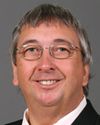Mr. Speaker, the Bloc Québécois supports Bill C-17 concerning Beechwood Cemetery in Ottawa. If Canada wants to create a national cemetery on Canadian land, that is Canada's business, and we of the Quebec nation respect that choice.
In addition, I am very happy to speak to this bill, because several famous Quebeckers are buried there.
I would like to extend sincere thanks to Michel Prévost, chair of the Outaouais historical society, for all the historical information he sent me to share with Quebeckers and Canadians about illustrious Quebeckers whose graves are in Beechwood Cemetery. Mr. Prévost is a consummate professional and a great guy. Thank you very much, Michel.
First, there is Alonzo Wright, a lumberman and politician, who was born on April 28, 1821 in Hull, Lower Canada, and died on January 7, 1894 in Ironside, Quebec. He was the grandson of Philemon Wright, the founder of Wrightville in Lower Canada.
There is a bridge over the Gatineau River that is named after him. Today, on some of the land he once worked stands the Collège Saint-Alexandre in the town of Touraine, in Gatineau.
In the rugged “Ottawa valley country”, he became, to his contemporaries, a “king” of the forest industry.
Alonzo Wright's political career spanned the years from 1863 to 1891. First elected as the member for the Quebec riding of Ottawa, under the infamous union forced by the equally infamous Lord Durham, he was re-elected five times in the Dominion. He was always elected under the banner of the Liberal-Conservative Party, whose first leader was John Alexander MacDonald. Prior to 1863, he was an admirer of the Reformers Robert Baldwin and Louis-Hippolyte La Fontaine. As a politician, he fought hard for his riding, championing agricultural development, colonization and the construction of canals and railways to link the region to what is now the rest of the Quebec nation. Perhaps with him, the Outaouais would already have its four-lane highway 50, but we will never know.
Another well-known Quebecker who has left her mark on Beechwood Cemetery is Élisabeth Bruyère. The founder and first superior of the Sisters of Charity of Bytown, she was born in L'Assomption, Lower Canada, on March 19, 1818 and died in Ottawa on April 5, 1876. A hospital in the Lowertown area of Ottawa bears her name, and there are streets named for her in Gatineau and Ottawa.
Mother Bruyère is not buried in Beechwood Cemetery, but a beautiful monument has been erected there in her honour. A Quebecker by birth, Mother Bruyère established a community that is present today in the Outaouais.
Under the protection of a cousin, abbé Charles-François Caron, the parish priest of Saint-Esprit in Montcalm County, she received a religious, intellectual, and domestic training of the highest quality. In 1834 she taught at the local school; she continued teaching at Saint-Vincent-de-Paul on Laval Island when her benefactor was transferred there in 1836.
Elisabeth was easily moved by the sufferings of others, and in 1839 entered the order of the Sisters of Charity of the Hôpital Général de Montréal, commonly called the Grey Nuns. In 1845, she went to Bytown where, under the yoke of the Act of Union, Franco-Ontarians had no schools, hospitals or organized assistance. Young Sister Bruyère was among those who served this community and surrounding ones. She had to combat the tragic typhus epidemic of 1847-1848.
The Grey Nuns saved some 475 of the 600 who fell ill. In addition, they were entrusted with the care of fifteen infant orphans. Mother Bruyère trained sisters in Bytown who opened no less than 25 houses serving as schools or hospitals under her control, such as St. Andrews West, near Cornwall, Ontario, or Timiskaming, known at the time as Canada West, and Buffalo, in New York State. Élisabeth Bruyère was a woman of courage and vision.
Louis-Théodore Besserer, notary, soldier, member of the Legislative Assembly of Lower Canada and businessman, was born in Château-Richer, near Quebec City, on January 4, 1785, and died in Ottawa on February 3, 1861.
He was a pupil at Petit Séminaire de Québec and then studied to become a notary.
At the beginning of the War of 1812, Besserer was a lieutenant in the 2nd militia battalion of the Quebec City district. He was transferred to the 6th battalion on March 20, 1813 and on September 25 of the same year was promoted captain. He represented the county of Quebec in the Legislative Assembly of Lower Canada from October 7, 1833 to March 27, 1838. He agreed with the Ninety-Two Resolutions and was a Patriote of the Quebec region.
Disappointed and embittered by political events, Besserer retired in 1845 to an immense estate he had purchased in 1828 near Bytown. A shrewd businessman, he had it subdivided into building sites, and gave Bishop Patrick Phelan a lot for a church and school in order to attract buyers. He also had several streets laid out, one of which, in Sandy Hill, still bears his name. This speculation brought him a fortune. Along with other fellow citizens, he was concerned with the incorporation of Bytown as a town, which took place in 1847.
Unfortunately, assimilation reared its ugly head. Mr. Besserer quickly became anglicized and, by the end of his life, considered himself to be a unilingual anglophone.
Sir George Halsey Perley was born in Lebanon, New Hampshire on September 12, 1857 and died on January 4, 1938. For half a century this Quebecker had a bridge between Grenville, Québec and my home town of Hawkesbury in eastern Ontario proudly named after him. The bridge that replaced it is now known as Long-Sault because it is in the area of New France where Dollard des Ormeaux died during a conflict.
Perley was a politician and a diplomat. Between 1904 and 1935, he was elected seven times as the federal member for Argenteuil—a seat now occupied by none other than our Bloc Québécois transport critic. He served, among other things, as minister of the overseas military forces during the first world war.
Many other people are buried in Beechwood Cemetery.
Built in 1873 in a hilly area surrounded by trees, it has winding paths, picturesque views and numerous wooded islets as well as its variety of trees, shrubs and ornamental plants. This place of pastoral beauty, which lends itself to reflection and commemoration of the dead, is also home to monuments of considerable artistic and historical significance. There is also a beautiful chapel on this sacred site.
In conclusion, I wish to express my sincere appreciation to my colleagues from Ottawa—Vanier, a Liberal, Ottawa—Orléans, a Conservative, and Ottawa Centre, from the NDP, who set aside partisanship and worked together with the Bloc Québécois to make this project a reality in their city.






